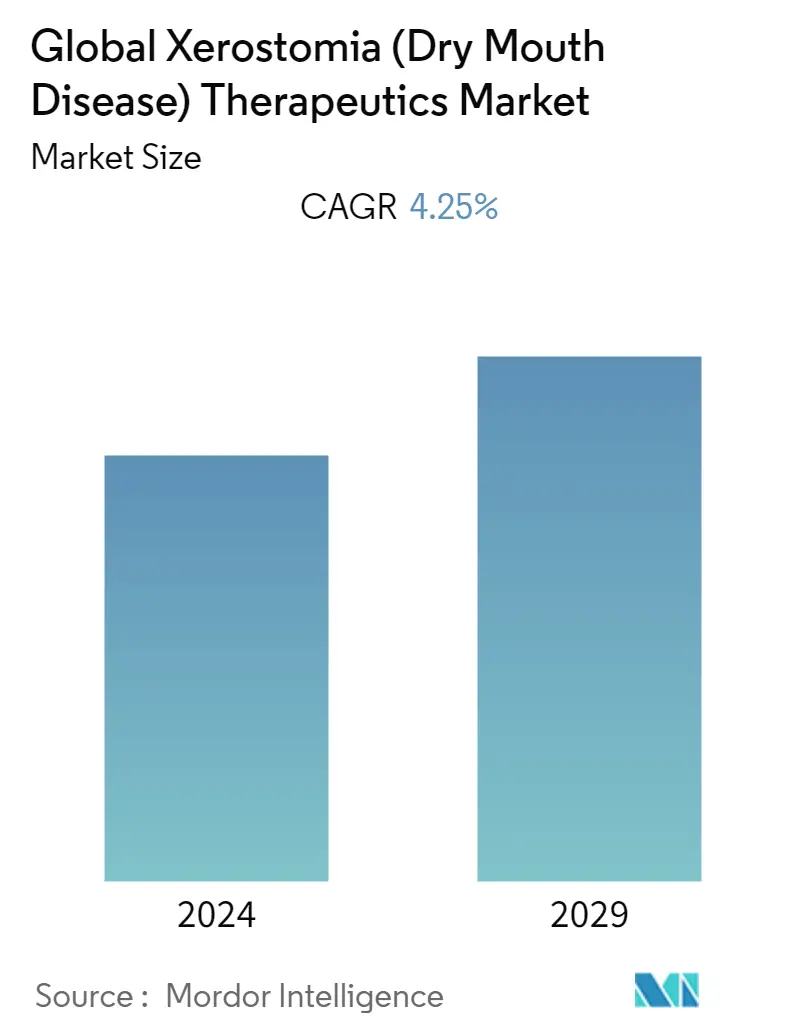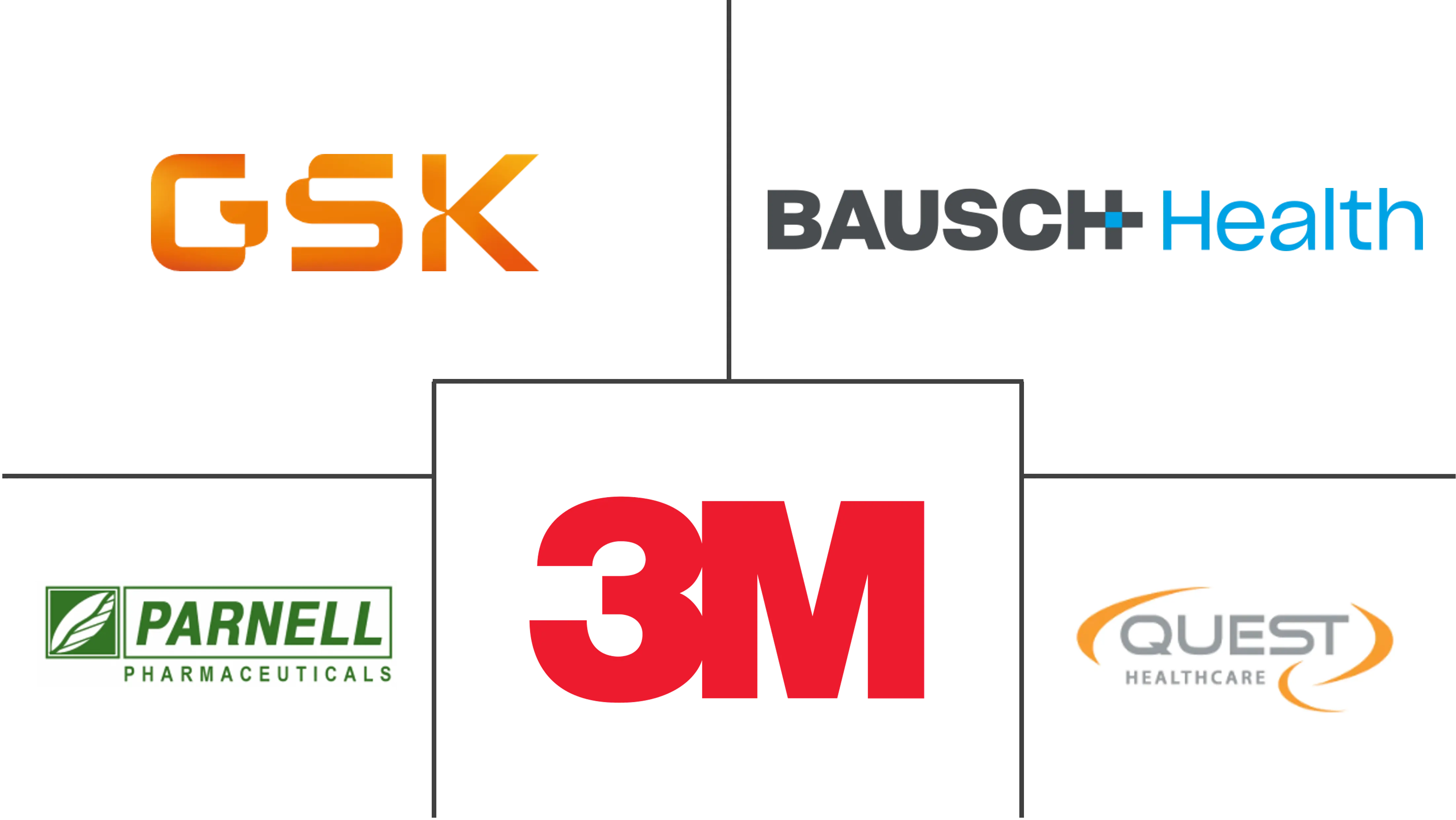Market Size of Global Xerostomia (Dry Mouth Disease) Therapeutics Industry

| Study Period | 2019 - 2029 |
| Base Year For Estimation | 2023 |
| Forecast Data Period | 2024 - 2029 |
| CAGR | 4.25 % |
| Fastest Growing Market | Asia Pacific |
| Largest Market | North America |
Major Players
*Disclaimer: Major Players sorted in no particular order |
Need a report that reflects how COVID-19 has impacted this market and its growth?
Xerostomia Dry Mouth Disease Therapeutics Market Analysis
The Xerostomia (Dry Mouth Disease) Therapeutics market is projected to register a CAGR of 4.25% during the forecast period (2022-2027).
The COVID-19 pandemic has posed new challenges in every aspect of an individual's life, including oral health. Dry mouth has become one of the most common problems that patients from all walks of life are dealing with. COVID-19 has also been linked to dry mouth as a symptom. According to the article titled "Xerostomia (dry mouth) in patients with COVID-19: a case series" published in April 2021, dry mouth appeared in 60% of cases 3-4 days before as a prodromal symptom and in others, simultaneously or 1-2 days after the onset of other symptoms. In the majority of cases, dry mouth improved over time after beginning treatment. The study further stated that in COVID-19 patients, xerostomia may develop before the onset of the common symptoms. Such studies demonstrate the frequency of the condition in COVID-19 patients and hence suggest that the demand for therapeutics for dry mouth disease is anticipated to grow in the near future. Thus, COVID-19 is expected to have a pronounced effect on the growth of the market.
Xerostomia commonly referred to as "dry mouth syndrome", is a result of reduced or absent salivary flow, producing mucosal dryness. The increase in radiation therapy and chemotherapy is likely to lead to an increased incidence of xerostomia, which is estimated to predominantly drive the xerostomia therapeutics market. Other factors driving the market growth include increasing usage of prescription medicines; easy availability and cost-effectiveness of medicines; a growing geriatric population base; and increasing prevalence of diseases, such as Sjogren's syndrome, HIV, diabetes, and Alzheimer's disease, among other diseases.
Additionally, the geriatric population is expected to have a significant impact on the market studied. For instance, according to the World Population Prospect, 2022, globally, in 2022, there were 771 million people aged 65 years or over, and it is projected to reach 994 million by 2030 and 1.6 billion by 2050. Elderly people frequently experience xerostomia, which is typically associated with reduced salivary gland activity. The use of drugs, chronic illnesses, and radiation therapy to the head and neck region have all been implicated as causes of xerostomia in the elderly population.
Furthermore, according to the International Diabetes Federation, as of 2021, there are 536.6 million people aged 20 -79 years around the world living with diabetes, and this number is expected to reach 783.7 million by 2045. Diabetes is often associated with dry mouth syndrome. For instance, as per the article titled "Xerostomia, Salivary Flow, and Oral Health Status Among Saudi Diabetic Patients: A Comparative Cross-Sectional Study" published in the National Library of Medicine in November 2021, Xerostomia was one of the symptoms of diabetes that was most frequently reported. In diabetic patients, xerostomia can occur anywhere between 12.5% and 76.4% of the time. Further, the study detailed that the data from the cross-sectional investigation of 50 diabetic patients in Saudi Arabia was collected, wherein 52% of controls and 60% of the diabetic participants both exhibited xerostomia. Thus, the growing burden of diseases leading to xerostomia is expected to drive the growth of the market.
Thus, the market is expected to experience significant growth over time. However, factors, such as lack of awareness and unavailability of effective treatment, are likely to hinder the usage of xerostomia therapeutics products and can act as a restraining factor for the xerostomia therapeutics market.
